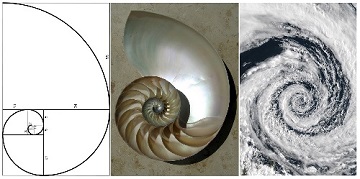 A Fibonacci spiral, a nautilus shell cut in half, and a hurricane all share links to Fibonacci numbers. Credits: Raiana Tomazini-Wikipedia, Wikipedia, NASA
A Fibonacci spiral, a nautilus shell cut in half, and a hurricane all share links to Fibonacci numbers. Credits: Raiana Tomazini-Wikipedia, Wikipedia, NASAThough the numbers look random at first — 0, 1, 1, 2, 3, 5, 8, 13, 21, 34, 55… — they actually follow a simple pattern: the next term in the series is the sum of the previous two terms. As the series increases, the ratio of any two consecutive Fibonacci numbers becomes increasingly closer to the “golden ratio,” which is approximately 1.618.
So where do these show up in the ocean? For one, the Fibonacci numbers themselves are common: Sea stars and sand dollars, for example, have five points, while squids and octopuses have eight arms. Yet, the golden ratio is far more common among all living creatures, including those in the sea. For example, the distance between the tips of a starfish’s arms compared to distance from tip to tip across the entire body is very close to the golden ratio, and the eye, fins and tail of dolphins all fall at points along the dolphin’s body that correspond to the ratio.
Perhaps the most famous example of all is the Fibonacci sequence expressed in the nautilus shell. If you place squares next to one another in which each new square has the width of the next number in the Fibonacci sequence, the resulting formation is a spiral that appears exactly in the nautilus — and in the spiral of hurricanes. As random as nature may appear at times, occasionally there is an underlying order.


